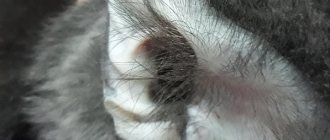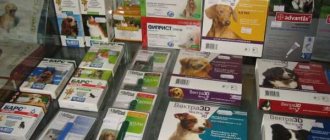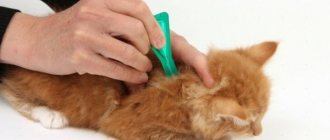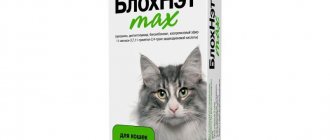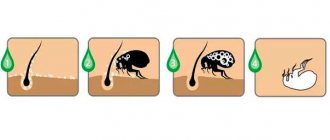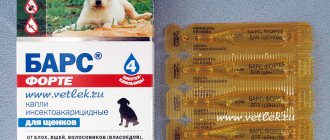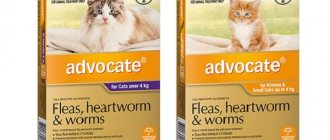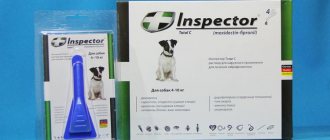Components of drip preparations
Flea drops for cats contain various types of toxic substances, and some types of drops do not contain toxic substances, but repellents that repel bloodsuckers. Not so long ago, anti-flea drugs were created on the basis of highly toxic compounds, for example, COCs.
However, the active substances of the vast majority of modern products are low or moderately dangerous. In the absence of contraindications and individual intolerance in the animal, the dosage is observed and used correctly, they do not cause negative consequences.
Varieties
In the production of insecticides for cats, the following groups of substances are used:
- avermectins;
- isoxazolines;
- chitin synthesis inhibitors;
- fipronil or phenylpyrazoles;
- pyrethroids;
- neonicotinoids;
- carbamates.
The composition of medications for cats most often includes:
- fipronil;
- imidacloprine;
- diazinon;
- moxidectin;
- Methoprene
It is the active substance that determines the mechanism of action of the drops, their toxicity, basic properties, and dosage.
Flea and tick drops: brands and effectiveness
Many manufacturers of veterinary products are producing insectoacaricidal drops. Let's look at the most common brands
"Leopard"
Insectoacaricidal drug of domestic production. The product has become quite widespread due to its low cost, as well as its sufficient effectiveness in the fight against fleas and ticks . The active component of Bars is the insecticide permethrin .
The main advantage of the drug is that its use causes virtually no side effects. In addition, under the same name, products are produced for kittens, which can be used from the age of two months.
In general, the action of Bars is effective, although sometimes the preventive effect is too short . As a rule, re-infection with parasites occurs within a few weeks after using the insecticide.
more about Bars in the article.
IN-AP complex
The drops contain components such as aversectin , fipronil and praziquantel . IN-AP drops is due to the fact that this product fights all types of parasites in cats, including worms .
Before treatment, it is necessary to examine the animal's skin for damage. If none are found, the pet needs to be washed , giving it the opportunity to dry. Only after this can the drops be applied. The product is highly effective in combating parasites, but does not provide a 100% guarantee of getting rid of fleas .
As reviews from customers who have used the drug show, sometimes insects are able to survive a drug attack .
Important ! IN-AP complex is not recommended for use on pregnant , lactating , or under two months of age .
Inspector
The drops are designed to combat ticks, fleas, lice-eaters and intestinal nematodes. The active components of the drug are fipronil and moxidectin .
The method of applying drops is the same as for other similar drugs. " Inspector " is not used on kittens under 7 weeks of age . It is used with caution on allergy-prone and pregnant animals .
The drops are considered highly effective in anthelmintic prevention and have a sufficient number of positive reviews from cat owners.
You can read more about Inspector
"Dana Ultra"
"Dana" is a domestic anti-flea drug based on fipronil. The effect of the drops lasts for 4 weeks. Treatment of the animal for the purpose of prevention is carried out no more than once a month. It is not recommended to bathe a cat for 3 days after treatment with the drug. In the future, bathing is not prohibited, since at this time it does not reduce the effectiveness of the product.
Operating principle
Based on the principle of action, anti-flea drops for cats are divided into two main groups:
- contact - after application, the product is distributed over the surface of the skin, absorbed into the upper layer of the epidermis, accumulates in the sebaceous glands and hair follicles and acts on parasites upon contact;
- systemic - the drug is absorbed into the blood and tissues of the animal and enters the insect’s body at the time of the bite.
Opinions among cat owners about the effectiveness and safety of medications vary. Some prefer to use systemic drops, considering them more effective. Others are of the opinion that systemic medications can be harmful to the pet, so they choose contact agents.
Mechanism of action
Drops against ticks and fleas for cats may differ in the amount of active ingredients and their types, but they all have the same mechanism of action. Drops on the withers are almost not absorbed into the blood of cats, but are absorbed into the hair follicles and skin.
How do all flea medications work? They have a paralyzing effect due to the parasite entering the gastrointestinal tract. When a flea or other parasite (tick, lice eater) bites, it receives a dose of a drug that disrupts the process of nerve impulse transmission and leads to paralysis of adult individuals. And the validity period of up to 2 months allows you to influence the young offspring hatched from eggs.
At what age are flea drops used?
Before you start using flea drops for cats, you must familiarize yourself with the age restrictions. They differ quite seriously for drugs from different brands and are always indicated in the instructions.
Most often, drops are allowed to be used for pets older than 2.5 - 3 months. If the animal is younger, then the product may do more harm than good. This is especially true for children who are under the care of their mother. While washing the baby, she licks off part of the drug, which gets into the milk, and with it into the kitten’s body, causing intoxication.
Kitten treatment
But fleas can plague kittens from birth. To alleviate the condition of a small pet, comb it out, bathe it in a saline solution or a special shampoo (after making sure that it is age appropriate).
Cases of overdose
An overdose of such drugs is possible only if the instructions for use are violated. It is accompanied by the following symptoms:
- Excessive salivation;
- Severe vomiting;
- Muscle cramps;
- The cat becomes lethargic and may refuse to eat.
If alarming symptoms appear, the animal must be shown to a veterinarian. If there are still traces of the drug on the body, they must be washed off as soon as possible.
When used correctly, flea drops will not harm your cat's health. You will help your pet quickly get rid of parasites and regain health.
If you find an error or inaccuracy, please select a piece of text and press Ctrl+Enter.
Small blood-sucking insects literally do not allow pets to live. They are especially annoying in the warm season - at the end of spring, summer, early autumn. Cat owners definitely need to know how to administer flea drops to their cat.
How often to treat?
Flea drops for cats last from 3 weeks to 3 months (usually 1-2 months). How often to apply flea drops to a pet is up to each owner to decide for himself, based on the condition of the animal and the presence of parasites. If a cat is infested with fleas, it must be treated as soon as the parasites are discovered. And then act according to the situation, based on how effective the treatment turned out to be.
For preventive purposes, drops should be used once every 3–6 months, and more often in the warm season than in winter (especially for walking cats).
Basic recommendations
Flea drops for cats are an effective and safe remedy that will quickly get rid of parasites. Today, such drugs are manufactured by various companies. When choosing, you should focus on the age and weight of your pet. Not all products are suitable for kittens and pregnant females. When using such drugs, the following recommendations must be observed:
- Before applying the product, carefully read the instructions. It tells you how many drops you will need and where it is best to drop them. Most often, it is enough to apply a couple of drops to the withers. Some products are recommended to be dripped at three points along the spine;
- Cat drops may not be effective if your cat gets wet after using them. Therefore, for several days after treatment, do not bathe the animal or let it go outside in rainy weather;
- Drops can also be used for preventive purposes. This is especially important if the cat is walking outside. In this case, it is sufficient to carry out the treatment once every six months;
- The product can only be applied to dry skin;
- Before using such products, it is better to consult a veterinarian, as they have some contraindications.
Following these recommendations will make the use of drops safe. The main thing is to start treatment as early as possible. Remember that a cat suffers greatly from a flea bite.
Rules for applying the drug
Before giving your pet flea drops, you need to know how to do it correctly in order to get maximum results and avoid negative consequences. There are several recommendations on how to drip correctly:
- the dosage of most drugs is calculated based on the weight of the animal, so before applying the drops, the pet must be weighed;
- if drops are used to get rid of fleas in kittens, you need to make sure that the product is age appropriate;
- you need to apply flea drops to a cat on the withers at the base of the skull, where the animal cannot reach to lick off the medicine;
- the skin should be dry and without damage.
Attention! Another rule is that the drops must fall not on the fur, but on the skin of the animal.
Flea drops for cats can be dangerous (video)
In order to rid an animal of parasites with the help of good modern means, the fur of a cat is parted at the withers, the drug is dripped in the required amount and rubbed into the skin with your fingers for greater reliability. After this, the cat does not need to be washed or combed for at least two or three days.
Some flea drops should be distributed along the spine at several points - this allows you to achieve a more pronounced effect. The number of drops that need to be applied to the cat's fur will vary from product to product.
Security measures
When applying flea drops and for the first time after the procedure, you must follow the following safety precautions:
- carefully ensure that the drops do not get on the mucous membranes or in the mouth of both the pet and the owner;
- apply the drug with gloves, then wash your hands thoroughly and dispose of the pipette or tube;
- do not eat, drink or smoke during the procedure;
- For the first 24 hours after applying the drops, do not pet your pet and do not allow small children or pets near it.
No ironing
Attention! If the drug is used for the first time, it is necessary to carefully monitor the pet’s condition in order to notice an allergic reaction in time.
What happens to fleas after treatment?
If the flea drops are based on a repellent, then after treatment the insects quickly leave the animal in order to be as far as possible from the unpleasant odor. If the drug is insecticidal, then it affects the nervous system of parasites, blocking receptors and disrupting the transmission of nerve impulses, as a result of which:
- fleas lose their ability to reproduce;
- insects cannot eat, breathe, move and die from paralysis.
Many drugs act not only on mature individuals, but also on larvae. The active substance penetrates into the egg, causing the death of the larva.
Review of popular flea drops - application, indications and contraindications
Never believe what it says on the label! That’s right, if the drops say “for kittens,” most likely we are talking about animals older than 2–3 months. For reference, animals under 9–12 months of age are also considered kittens, so manufacturers do not lie when they place colorful labels on packages.
Important! There are no absolutely safe flea drops. Always read the instructions before use! If you have any doubts about the safety of the drug, it is better to consult a veterinarian.
Leopard
The drug differs from most drops in the number of components. The main active ingredients of Bars drops are:
- Fipronil.
- Diflubenzuron.
- Dicarboximide.
Interacting, the active substances give a relatively good result, against the background of low toxicity. Once in the body of parasites, the active substances disrupt the functioning of their nervous system, which quickly leads to paralysis, and within 2-4 hours to death. In addition, Bars drops have a detrimental effect not only on adult parasites, but also on their eggs. Simply put, drop treatment interrupts the flea reproduction cycle, and this is very important at any stage of the infestation.
Indications for use: elimination of skin parasites, including fleas, lice, lice, subcutaneous and pasture ticks in animals older than 2 months.
Contraindications to the use of Bars drops:
- Individual intolerance.
- Acute allergic reactions.
- Immunocompromised animals: dehydrated, malnourished, sick or recovering from illness.
- Carriers of a viral infection.
- Kittens under 8 weeks and cats over 12 years old.
- When treating ear mites, the use of drops in case of perforation of the eardrum is not recommended.
According to the manufacturer, the active ingredients are distributed throughout the deep layers of the skin without penetrating into the systemic bloodstream. When used externally, the drug is considered moderately toxic, but drops must be used observing all safety precautions. Upon contact with mucous membranes, the active ingredients of Bars drops cause irritation; if swallowed, the toxicity of the drug increases sharply.
The recommended dosage is as follows:
- Cats weighing up to 1 kg – 0.3 ml.
- Cats weighing 1–3 kg – 0.6 ml.
- Cats weighing more than 3 kg – 1 ml.
Important! Drops are applied only to dry, intact skin.
Celandine
According to the manufacturer, Celandine drops can be used to prevent and treat infestations of skin parasites in kittens and adult cats. The residual effect of the drug lasts up to 2 months against fleas and up to 1 month against pasture ticks.
The active ingredients of Celandine drops are:
- Fipronil.
- Permethrin.
The range of the drug is aimed at combating external parasites: fleas, lice, lice and ticks. In addition, Celandine is prescribed for the treatment of subcutaneous mites. According to the manufacturer, the composition of the drops helps to effectively fight parasites at different stages of growth (from egg to mature individual). The active ingredients of the drops disrupt nerve conduction in parasites, which leads to their paralysis and death.
Contraindications to the use of Celandine drops:
- Kittens under 8 weeks old.
- Cats over 12 years old.
- Animals suffering from liver and kidney pathologies.
- Virus carriers.
- Weakened, emaciated, dehydrated animals.
- Animals that are sick or recovering from illness.
Note! When used externally in recommended doses, the drug is classified as moderately dangerous. Upon contact with mucous membranes, the active substances cause severe irritation. When licked and swallowed, drops can lead to both local reactions (salivation, allergies) and poisoning.
The dosage of Celandine drops is calculated by the weight of the animal:
- For cats weighing up to 2 kg – 0.5 ml.
- For cats weighing over 2 kg – 1 ml.
What affects the effectiveness of the drops?
First of all, the effectiveness of using drops depends on the correct choice of drug and accurate dosage. It is also important to follow the rules of application, as well as adherence to safety measures.
However, just applying drops to the withers is not enough. It is necessary to clean and treat the room where the pet lives and especially its place - bed, house. The most effective way is to wash the floors with an anti-flea agent and treat carpeting, baseboards, cracks and pet bedding with an anti-flea spray.
Mechanism of action of drops against worms, method of application
Drops should be applied to dry, intact skin in places that are inaccessible for licking (neck, base of the skull). To do this, use a special pipette. Drops are produced in different formats, depending on the weight of the animal: 0.5-2.5 kg, up to 4 kg, up to 5 kg, etc. If the cat does lick the medicine, it may experience increased salivation and vomiting.
The mechanism of action of drops against worms is the depolarization of the neuromuscular receptors of the parasite, disruption of glucose transport, microtubular function, which leads to muscle paralysis and death. To apply the drops, you need to part the hair at the back of the head, break off the top part of the polymer pipette and squeeze its contents onto the skin. For a large animal, drops are applied to 3-4 points.
Advice : cats should be given deworming tablets (as an alternative, you can use a suspension, drops on the withers) once every 3 months, as well as before vaccination, mating and 10 days before giving birth.
As a rule, deworming drops on the withers are not recommended for use on kittens younger than 8 weeks and weighing less than 0.5 kg. For each drug, the instructions contain a list of contraindications, for example, for emaciated animals, patients with infectious diseases, kittens under 7 weeks of age, lactating cats, etc. Typically, the minimum therapeutic dose of the drug is 0.1 ml per 1 kg of animal weight. After applying anti-worm drops, it is not recommended to wash the animal for 4 days.
Rarely, allergic reactions may occur after applying drops to the withers against worms: dermatitis, vomiting, loss of appetite. If your cat becomes irritated after using the medication, wash it off with warm water and soap and briefly hold the affected skin area under running water. It should be borne in mind that anti-worm medications in the form of drops are most effective against roundworms and tapeworms. For example, cat fluke (flatworm) in a cat can only be cured with hexachloroparaxylene, ixichol, or polytreme, taken orally.
Anthelmintic drugs for cats have a wide spectrum of action and are also used to remove skin parasites. When do ticks appear on cats? They are contracted from an infected animal, so you should limit your domestic cat’s contact with outdoor animals.
When can you wash your cat after applying the drops?
You can wash your cat 2-3 days before the procedure and 2-3 days after it. This is necessary so that a protective fat layer has time to form on the animal’s body before applying the drops, and so that the medicine has time to be absorbed into the skin after the procedure.
The duration largely depends on the composition of the chosen product and the mechanism of its action on parasites. So water-based products are absorbed in 1-2 days, while oil-based drops need 3 to 5 days.
Attention! The only reason to wash your cat after the procedure without waiting until the due date is the symptoms of an allergic reaction (redness of the skin, itching, scratching).
Fleas on a cat
There are many drugs available to get rid of parasites. Owners are often lost in choosing the best option for their pet. However, a flea remedy for cats can be selected quite easily if you take into account all the characteristics of your pet and its living conditions.
Collars
One of the most popular means of fighting cat fleas is a collar. It is better to use it either before infection, or after getting rid of parasites for prevention.
When purchasing a collar, it is very important to know its expiration date in a closed package and the expiration date after removal, directly on the animal itself. Usually the product works for a month, and then its effectiveness decreases. There should be no damage to the packaging, otherwise the drug may deteriorate even before it is used.
Pros:
- Collars are easy to find in pet stores.
- You can choose the appropriate size.
Minuses:
- This is still more preventive than curative.
- In some cats, the collar causes allergies and discomfort.
Sprays
The most effective and at the same time the most dangerous remedy due to the high concentration of the active substance and its toxicity. It is recommended to use only in exceptional cases and in case of very severe parasite infestation, and only after consultation with a specialist. Sprays are used only for adult cats without health problems.
When spraying the product, it is very important to ensure that it does not get on the animal’s face or ears, otherwise it can cause severe intoxication. It is recommended to handle the animal with gloves and in a well-ventilated area. Some sprays, if indicated in the instructions, can also be used to treat furniture, floors and other things.
Pros:
- Sprays kill fleas and their eggs immediately after application, and their duration of action lasts for about a month.
Minuses:
- May cause a severe allergic reaction or poisoning of the animal, severe side effects.
Drops
The drops are effective and quite safe if the instructions and precautions are followed. They are easy to use and can be easily found at any pet store. Their validity period, depending on the manufacturer, can vary from a month to six months.
The drops are applied to the animal's withers so that the animal cannot reach this place and lick itself. However, sometimes the product can spread, and when washing the cat, it can reach, for example, its shoulder blades. Therefore, after processing, the owner’s task is to ensure that this does not happen.
Pros:
- Some drops immediately include components for getting rid of helminths and ticks.
Minuses:
- 3 days before applying the drug and for 5 days after, you should not wash the animal or allow it to be exposed to the rain. The drops are applied to the animal's skin and spread over the upper layer of the epidermis over 3-5 days. When the animal gets wet, the fat, due to which the product spreads throughout the cat’s body, is washed away, and along with it the drug.
What to do if the drops don't help?
There may be several reasons why treatment with drops is ineffective:
- incorrectly selected product;
- incorrect dosage;
- violation of the rules for applying drops;
- using an expired drug.
In addition, the cause may be constant contact with an infected animal or the presence of fleas in the house. In any case, if the applied drops do not help, you should take several steps:
- change the drug;
- treat your house and other pets for fleas;
- try other products, such as a shampoo and collar combination.
Shampoo application
If these measures do not help, you should contact a veterinarian who will help you choose an effective remedy.
Emergency situations after use
The most common surprise that awaits pet owners after treating their cats with flea drops is a visible worsening of the situation. The animal begins to itch furiously and bite off its fur. This is explained by the fact that immediately after applying the drug, the parasites become more aggressive. This continues for several hours, a maximum of a day, after which the situation returns to normal.
Another unpleasant surprise is the pet’s allergic reaction to the drug. This is evidenced by weakness, vomiting, diarrhea, itching and redness of the skin. In this case, you must immediately wash off the drops and, if necessary, give the cat an antihistamine.
Symptoms and prevention
Drops against fleas and ticks are used for therapeutic and preventive purposes. The biggest mistake an animal owner will make is not paying attention to this problem.
© shutterstock
Signs of parasites
The presence of parasites on a cat’s body is easy to notice. Because these insects suck blood from the animal, cats experience discomfort and show signs of anxiety . The animal begins not only to itch, but to bite itself at the location of the flea. Ticks, as a rule, settle in a cat's ears in the form of a black substance that is clearly visible to the naked eye. The pet will also scratch the affected ear furiously, sometimes until it bleeds. While scratching its ears or body, a cat attacked by parasites will meow pitifully, seeking sympathy from the owner.
Prophylactic use
Having discovered similar symptoms in an animal, responsible fur owners drip a special drug onto the cat’s withers. By eliminating parasites, it quickly relieves your pet from suffering. However, a good way to prevent them altogether is to use preventive drops.
Periodic use of the product is especially necessary for cats that are allowed to walk outside. For example, during the summer season, when an animal that has been locked up for several months suddenly gains freedom. To prevent the cat from acquiring fleas and ticks along with it, the owner needs to treat the pet’s withers with an effective anti-parasite drug.
Advantages and disadvantages of drops
Using drops is one of the most popular ways to remove fleas from your pet. This form of medication has several advantages:
- high efficiency;
- versatility;
- quick achievement of results;
- simplicity and ease of use;
- action over a long period;
- safety with correct dosage and application.
But before using drops, you need to know about their disadvantages:
- risk of allergies;
- danger for small kittens, pregnant and lactating cats, weakened animals.
Types of anthelmintic drugs in the form of drops for cats
| Name | Golden Defense | Helminthal spot-on | Profender | Inspector Total K |
| Active substance | Imidacloprid, moxidectin | moxidectin, praziquantel | emodepside, praziquantel | fipronil, moxidectin |
| Indications | Against fleas, lice, lice, subcutaneous and ear mites, helminths (roundworms, difilaria) | Roundworms, tapeworms, fleas. | Roundworms, tapeworms, also their larval forms. | Ticks, fleas, lice eaters, larvae and mature forms of roundworms, heartworms. |
| Average price (depending on the manufacturer, dosage, number of pipettes in the package) | 250-300 rub. | 175-230 rub. | 280-625 rub. | 300-400 rub. |
Advice : if the cat is pregnant, nursing, or the kitten weighs less than 1 kg, the choice of an anthelmintic drug (even for prevention) is best done together with a veterinarian.
There are many other effective drugs in the form of drops for removing and preventing worms in cats, for example, Dironet, Stronghold, Advocate. The choice should be based on the type of pathogen against which the medicine will be highly effective, the age, and weight of the animal. There are many positive reviews about Drontal for cats (it comes in tablet form).
Drops on the withers against worms are an excellent alternative to tablets and suspension for cats. With their help, you can cure or protect the animal from parasites without unnecessary stress for it. The pharmaceutical market provides many options for drugs based on different active ingredients at an affordable price.
Toxicity and side effects
Since most drops used to treat cats against fleas are still toxic, their use in some cases can cause side effects:
- redness or swelling of the skin at the site of application of the drops;
- lethargy;
- itching;
- increased salivation;
- nausea, vomiting;
- diarrhea;
- lacrimation;
- trembling (in severe cases, convulsions).
Itching
Most often, an adverse reaction occurs from the use of the wrong drug, non-compliance with dosage or safety precautions.
